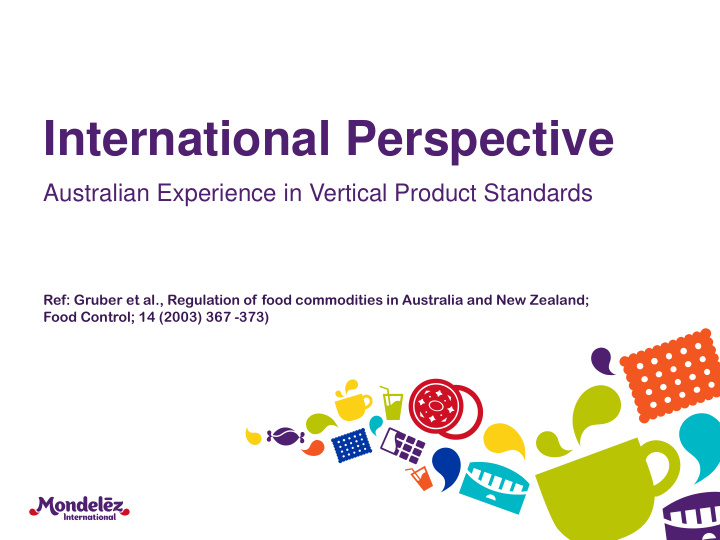



International Perspective Australian Experience in Vertical Product Standards Ref: Gruber et al., Regulation of food commodities in Australia and New Zealand; Food Control; 14 (2003) 367 -373)
Background: • A complete new set of standards for food commodities was adopted in December 2000. • The policies underpinning these standards aim to protect public health and safety while facilitating industry innovation in the market, and hence improve consumer choice. • The aim in reviewing the commodity standards was to develop new food product standards that reduce the regulatory burden, are easier to understand and amend, and reflect the advances in scientific knowledge in areas such as nutrition, toxicology and allergenicity. • Provisions that apply to all foods, such as labelling requirements and food additive permissions, were grouped into generic standards that cover all foods. Where specific provisions were required for particular food commodities, based on stated objectives, then commodity-specific regulations were developed. • These commodity standards also reflect the move towards a more internationally consistent regime of food regulation.
Challenges Identified Standards out of step with needs of industry and consumers Highly prescriptive standards, impeded innovation Standards were based on traditional diets, and not on modern changed dietary patterns Standards didn’t recognize the developments in consumer protection laws
Policy Principles: Reduce the level of prescriptiveness of standards to provide wider permissions on use of range of ingredients, additives Replace standards which control individual foods with ones which control all foods or range of foods. Developing definitional standards in appropriate cases. Retaining standards for individual standards only if consistent with objectives. Redraft standards for easy understanding, amendments
Specific Objectives Take account of changes in food supply and take General General steps to reduce regulatory Standards burden on food industry. Standards Reflect recent advances in scientific knowledge. Commodity Commodity Standards Standards Ensure greater protection for consumers. Landscape Shift
Decision Tree: Is the aim of the standard to protect public health and safety, prevent fraud and deception, provide adequate information relating to food to enable consumers to make informed choices or to facilitate trade? Yes No Can the aim be met through a generic standards? No No Standard Required Yes Can the aim be met through any other means?* No Can the aim be met through a minimum definition and generic Labelling provisions? Yes No Standard Required No Develop a Commodity Standard *e.g. other legislations, such as: fair trading laws, Code of Practice, Guidelines
Question? Learnings for India Food Regulatory Frameworks
India: Coverage by Horizontal & Vertical Standards S. HORIZONTAL STANDARDS VERTICAL SCOPE/ COVERAGE No STANDARDS STANDARISED PROPRIETARY . 1 Food Contaminants (Heavy metals, Toxins Yes Yes etc.) 2 Pesticide Residues Yes Yes 3 Antibiotics, Veterinary Drugs Residues Yes Yes 4 Food Packaging and Labelling Yes Yes 5 Licensing and Registration Yes Yes 6 Laboratory and Samples Analysis Yes Yes 7 Food Additives Yes Yes 8 Microbiology Yes Yes 9 Prohibition and Restriction on Sales. Yes Yes 10 Food Product Yes NO Standards ENFORCEMENT / SURVEILLANCE Yes YES
Food Safety Pillars HORIZONTAL COMPOSITIONAL Food Manufacturing Processes: Ingredients Additives • Food Safety Management System Pre-approval Novel Packing & Storage for specific Ingredients category • Packaging • Good Storage Practices General Ingredients Consumer Information PRE • Food Labelling History of APPROVAL Use
Conclusions Development of food product standards for food commodities as embodied in the Australia New Zealand Food Standards Code (Volume 2) reflects a move towards a more internationally consistent regime of food regulation. This has resulted in the replacement of food standards that regulate individual foods with standards that apply across a range of foods, and should also apply to new products as they are developed and become part of the food supply. It is possible to create a win - win situation by creating a regulatory system that: Is both accountable and transparent; Provides the consumer with adequate information to make informed choices; Enables the consumer to exercise choice through buying products which are adequately labelled. In turn this has led to food standards that are: easier to understand. reduce the level of prescriptiveness, thereby promoting innovation.
Thank You…………. Dr. Jasvir Singh Sc. Affairs, Regulatory Affairs Mondelez India Foods Pvt. Limited
Recommend
More recommend